|
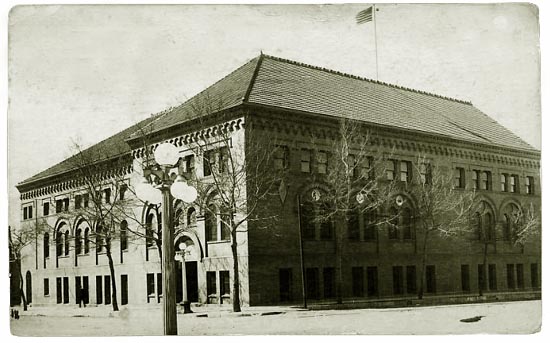
Cheyenne Masonic Temple, 1922
The temple was built in 1901 by the Scottish Rite at a cost of $45,000. In 1903, the building was gutted by a fire
believed to have started in the electrical wiring., the interior was reconstructed. The damages were estimated by the Tribune,
March 1, at $50,000 with only $35,000 in
insurance coverage.
Fraternal Orders in Wyoming date to prior to the formation
of the Territory. Indeed, the first Masonic Lodge
meeting was conducted at Independence Rock on July 4, 1862. In Cheyenne, fraternal orders included in addition to the Masons, and
the Knights of Pythias discussed on a prior page, the Odd Fellows, the Improved Order of Redmen (discussed with regard to
Casper), the Knights of Columbus, the Grand Army of the Republic, the
Fraternal Order of Eagles, the Modern Woodmen of America, the Woodmen of the World, and the Benevolent and Protective Order of Elks.
Masonry in Cheyenne dates to 1868 with the receipt of a dispensation on February 22, 1868 from Colorado to form a
Lodge. In October, Cheyenne Lodge No. 16 was formed. A charter for Cheyenne Lodge No. 1 was
received from the Grand Lodge of Wyoming on Dec. 16, 1874. Freemasonry, in theory, traces its history to
the construction of King Solomon's Temple. Historically, it can be traced to
lodges in the British Isles. Organized Masonry traces its
history to the formation of the Grand Lodge of England on June 24, 1717, at the Goose
and Gridiron Ale House, St. Paul's Churchyard, when representatives of
four London Lodges elected Anthony Sayer as the first Grand Master. By 1820,
"operative" Masons, i.e. members of the craft, had generally lost control of the
organization to "accepted" Masons, i.e., individuals who were not members of
the craft but who were "accepted" into the Order. The Grand Lodge of Wyoming was formed
in the early 1870's.
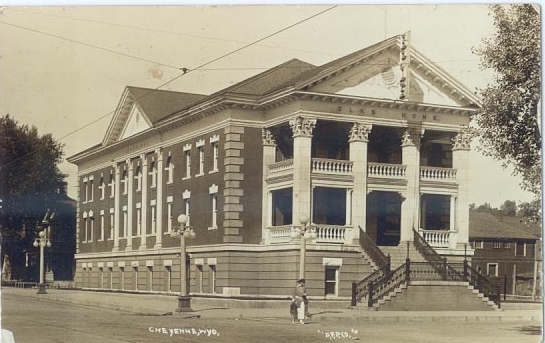
Cheyenne Elks Lodge, approx. 1911
As noted on a previous page, the Cheyenne Elks Lodge at 100 E. 17th Street, pictured above, was designed by William R. Dubois. Dubois
served as the lodge organist. The lodge was organized in 1901. One of the first activities was a fund raising baseball game with members of the
Shrine. At the baseball game, the lineup for the Elks included such
luminaries as Joe Cahill, and Walter Stoll and Harry Hynds. J. McCabe was the "offiical
bandage carrier," A. D. Kelley as the "official water carrier," and Thomas Murray was to hold all
inquests. Cahill during part of the 1901-02 seasons served as manager for the Cheyenne Indians and later as Manager
for the Knights of Columbus baseball team. Players for the Shriners included E. L. Slack, Sam Idelman, and R.S. Van Tassell.
The proceeds were donated to the County Hospital Ladies Relief Association.
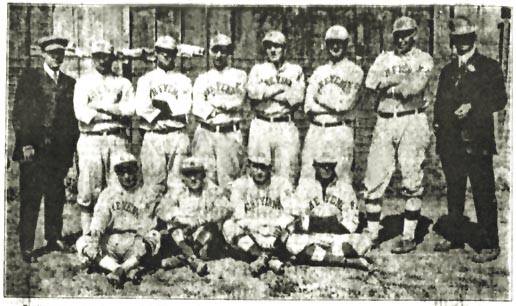
Cheyenne Knights of Columbus baseball team, 1914
Standing on Left in dark suit, J. J. Meinerhey, Grand Knight and Secretary of the City Baseball League. At right end in suit, T. Joe Cahill, manager.
The Shrine-Elks ball game was preceded by a parade with a fourteen piece band. The Shrine, then as now, loved parades.
One of the more memorable was in 1909 when 100 shriners from Los Angeles on their was to a convention
in Louisvile passed through town with a brass band. Their entrance at the Union Pacific Depot was signaled by a
calliope playing, "Cheyenne, Cheyenne, Jump on Your Pony," followed by their chief musician manipulating a
train whistle which could play a whole octave. The song on the train whistle was played with such skill that most of the people could
understand what song he was attempting to play. When the shriners stopped in Laramie, the fire department mistook it for
a fire alarm.
It was not the only time that Shriners came through town and created a stir. The Tribune, June 18, 1921, in a front page
story reported that two train loads of Shriners from the Des Moines conclave and went through the streets with a crack
drill team and a 48-piece band:
Most of the Shriners expected to see Indians and cowboys, and one member of the party was greatly disappointed when, upon inquiring of a
bystander where the denizens of the wild west shows could be found, he was informed that they
were put to bed promptly at 9:00 o'clock every night.
The Shrine was not the only one to use a calliope. Until it was destroyed in a fire,
the Elks would occasionally borrow C. B. Irwin's calliope for use in a parade which would be played by George F. Storey (1891-1964). In one parade on April 12, 1918, it was a bit chilly.
Someone had the idea to prevent George from getting too cold, the sides of the calliope could be closed in with
canvas. They forgot that the air compressor was powered by a small gasoline engine. George was overcome with
carbon monoxide poisoning. Nevertheless, he recovered and three weeks later was back playing the
calliope in another parade. The Woodmen of the World had their own band as did the
Union Pacific Employees Club.

Union Pacific Employees Club Band, 1924.
The Union Pacific Employees Clubs began with Club No. 1 organized in Cheyenne in 1924. There are now 57 clubs system wide.
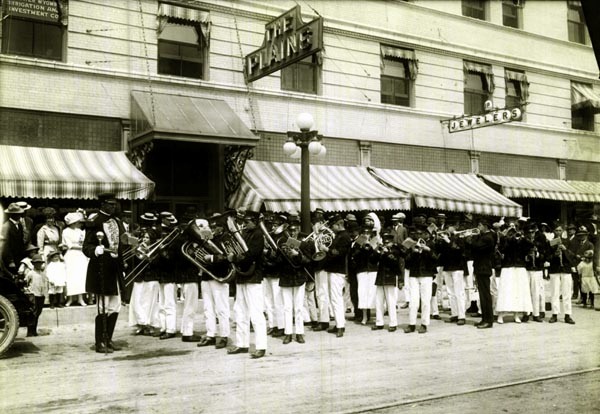
Denver Post Employees Band in front of Plains Hotel, 1912.
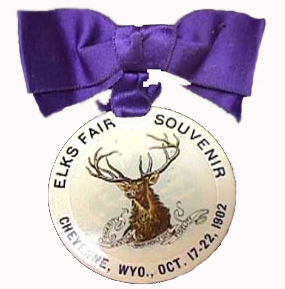 Other early Elk fund raisers included, as indicated by the badge to the
right, street fairs. Other activities included minstrel shows. The proceeds of the 1903 Minstrel Show went
to the building fund. The cornerstone for
the Lodge Building was laid on August 28, 1902. The $40,000 building was dedicated by Grand Exalted Ruler Joseph T. Fanning on November 16, 1903. Other early Elk fund raisers included, as indicated by the badge to the
right, street fairs. Other activities included minstrel shows. The proceeds of the 1903 Minstrel Show went
to the building fund. The cornerstone for
the Lodge Building was laid on August 28, 1902. The $40,000 building was dedicated by Grand Exalted Ruler Joseph T. Fanning on November 16, 1903.
Although Elks Lodge 660 has continued to occupy the same building, over the years it has been expanded and modified.
First, the front porches were enclosed and the roof line changed.then the front of the building was altered, eliminating the
Corinthian columns and th grand staircase so that the building now has a 1960's appearance.
Organizations in Cheyenne which had bands included the Woodmen of the World and the Union Pacific Employees.
The B.P.O.Elks was founded in New York on Feb. 16, 1868, by entertainers who would meet
above the Jolly Cork Tavern.
Its founder is regarded as Charles Algernon Sidney
Vivian (1842-1880), an English music hall
entertainer, who was a member of the Royal
Antediluvian Order of Buffaloes in England. Vivian died in Leadville, Colo.,
Mar. 20, 1880. At the time of his death. he was the leader of a repertoire company performing in Leadville. The RAOB and the "Eleven O'Clock
symbol on the Elks' emblem and the Elks' Eleven O'Clock Toast, in theory,
trace their history to the period prior to the Norman Invasion of England in 1066. During
the 1067 uprising, Oda, half-brother of King William, instituted a curfew, from the
Norman French term couvre le feu, "cover the fire," when all hearth fires were required
to be banked at 11:00, thus ending all meetings. At the hour of 11:00 a toast was
made in remembrance of those who were gone. Historically, the RAOB can be
traced to approximately 1820 and lodges in London and Bristol.
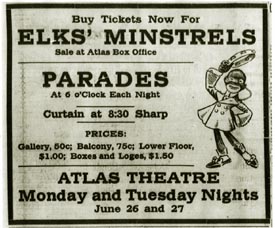 Advertisment for
Elks' Minsrels, 1916. Advertisment for
Elks' Minsrels, 1916.
Following the Civil War until the early 1960's one of the most popular forms of entertainment throughout the country were Minstral shows. Indeed,
Sheridan Corbyn, an early manager for Elks founder Charles Vivian, booked the Georgia Minstrels into St. George's Hall, Melbourne,
Australia. The Georgia Minstrels, according to an advertisment in the Melbourne Argus, July 30, 1877, consisted of "Real Negroes from the Slave States." See Annotation in
The Life of Charles Algernon Sidney Vivian, by Imogen Holbrook Vivian, annotated by
G. B. Dobson, p. 20, privately printed, 2011. All woman minstrels also were put on. As an example in 1905 the Wheatland Library Association put on an all woman
minstrel show. In 1914 the Lander Lady Boosters also put on a minstrel show.
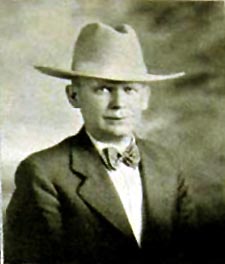 Right, Ed Storey,
approx. 1930. Right, Ed Storey,
approx. 1930.
In Cheyenne,
the Elks followed the tradition of the early founders
of their order in putting on such shows. Indeed, Vivian himself appeared on occasion in
blackface. One of the favorite minstrel shows in Cheyenne was the regular "Elks Mammoth Minstral Extravaganza" in which both
George Storey and Ed Storey (1887-1955) appeared. Ed served as Exalted Ruler of the Lodge in 1916-1917.
Ed was also active in the Knights of Columbus. Cheyenne Council 801, Knights of Columbus was
instituted on July 12, 1903. The exposition of the three degrees took an entire day. Membrship in multiple fratrnal orders was not
unusual which occasionally leads to some confusion where in Elks lodges the Exalted Ruler has been
addressed as "Worthy Master" or on one occasion when the Elks Loyal Knight began to give the Masonic Junior Warden's charge.
Minstral shows in addition to music also had
a dialogue between an "interlocotor" and two end men generally referred to a Tambo and Bones. Tambo would play a tamborine and Bones, the bones.
The diaglogue produced jokes that would now generally be referred to a "groaners." A typical dialogue be after answering a question from the Interlocotor, Bones described going out
on the Prairie to find a prairie dog to send to a lady friend. He waited all day at a prairie dog hole for the
prairie dog to come out. Eventually, however, a rattlesanke emerged:
Inter. Oh, Bones, while there did you meet any Indians?
Bones. No Injuns there--all gone to the happy hunting-ground!
Inter. Oh, why do they call their heaven that?
Bones. 'Cause there are no Injun agents there and no white sojers to stop them from hunting!
And another which might have some applicability in recent years. Bones described his application for a job as
a motorman on the street car. The Interlocotor asked Bones if the street car line was particular about the character of their
employees, to which Bones rsponded, "Boss, they is more particular than over a bank cashier. Considering
how low bank profits are now, I guess a car-conductor handles more 'ready' than those fellers."
One of the highlights of
the 1916 show was Ed Storey singing "Are You From Dixie." Ed was the consumate volunteer. Beside the Elks, he was active in the
American Legion, the Chamber of Commerce and the Knights of Pythias. He wrote the by-laws for the HEELS, an organization of
vounteers who assisted in putting on Frontier Days. The three pinciple officers of the HEELS are the
Leather Heel, the Rubber Heel and the Run Down Heel.
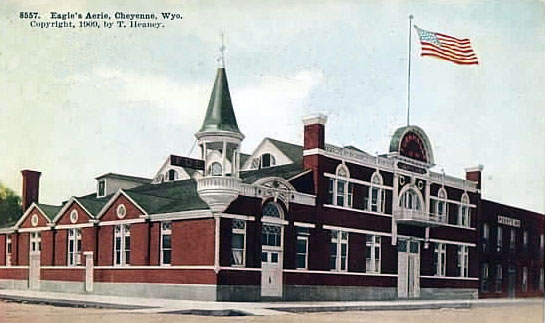
Cheyenne Eagles Aerie, 1909
The Elks were not the only fraternal order in Cheyenne to sponsor or put on shows. In 1914, the Fraternal Order of Eagles sponsored a
Carnival which featured the Allman Bros. Traveling Carnival.
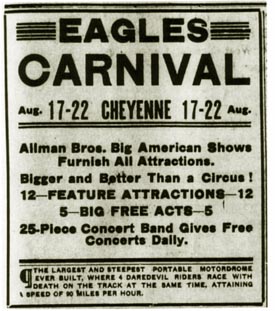 Advertisement for Eagles Carnival, 1914. Advertisement for Eagles Carnival, 1914.
As indicated in the advertisment, the show featured a "motordrome" in which the walls were inclined at an 80 degree angle and on which which motorcyclists
roared around at speeds of 90 miles an hour. The audience sat 30 feet above looking down into
the "bowl of death." The show also featured a horse and mule act. In the act, a mare named
"Sahara" would go to bed, cover and uncover herself, use a typewriter, a cash register and turn on and off
electric lights. In another act, a small house in which there was a small child would be set on fire. A mule
named "Maxine" would break out of her stable at the opposite end of the tent,
rush into the burning house and carry the child out in her mouth.
The Fraternal Order of Eagles was formed in 1898 in Seattle by six theatre owners. Just as in the case
of the Benevolent and Protective Order of Elks, the Order in the beginning consisted of
actors and professional entertainers who often meeting in theaters. Aeries were formed in Wyoming as early as 1901 with the formation of Eagles Aeries in
Evanston and Saratoga. The order had fantastic growth. B the time of the formation of the Evanston aerie, the order boasted of
some 60,000 members. Four years in 1905 at the time of the meeting of the Grand Aerie in Denver, the
Order claimed some 195,000 members in 1,032 aeries. One of the most
prominent members of the Cheyenne Aerie No. 128 was Theodore Roosevelt who was initiated into
the Order in April of 1903. Roosevelt was one of six presidents to belong to the Eagles but the
only President belongin to a fraternal order whose home lodge was in Wyoming.
Other early fraternal orders in Cheyenne included the Odd Fellows whose lodge was instituted on April 13, 1868. One short-lived fraternal order
was the National Order of Cowboy Rangers. Lodges were called "Ranches" The officers were "Boss of the Ranch,
"Vice Boss," "Junion Past Boss," "Recorder of Brands," "Pay Boss," "Sky Pilot," "Boss of Spur," "Guard of the Corral,"
"Guard of the Roundup," as well as the Trustees. The first "Ranch" was Denver Ranch No. 1. Cheyenne Ranch No. 2 was instituted in
1915. Other Ranches in wyoming were located in Big Piney, Rawlins, Buffalo, and Laramie. By 1918, the Order claimed to have
18 ranches with 2,500 members. Membership was limited to cowboys and former cowboys.
Music this Page, courtesy Horse Creek Cowboy:
ARE YOU FROM DIXIE?
Lyrics, Jack Yellen.
Music, George L. Cobb,
1915
Hello there, stranger! How do you do?
There's something I'd like to say to you.
Don't' be surprised. You're recognized.
I'm no detective, but I just surmised
You're from the place where I long to be.
Your smiling face seems to say to me.
You're from my own land, my sunny homeland.
Tell me, can it be?
Are you from Dixie? I said, from Dixie,
Where the fields of cotton beckon to me.
I'm glad to see you. Tell me, how be you?
And the friends I'm longing to see?
If you're from Alabama, Tennessee, or Caroline,
Any place below the Mason-Dixon Line,
Then you're from Dixie. Hooray for Dixie!
'Cause I'm from Dixie, too.
It was away back in eighty-nine
I crossed the old Mason-Dixon Line.
Gee! but I've yearned, longed to return
To all the good old pals I left behind.
My home is way down there in Alabam'
On a plantation near Birmingham.
And one thing's certain, I'm surely flirtin'
With those southbound trains.
Next Page: Grand Army of the Republic, Woodmen of the World, Modern Woodmen of
America.
|